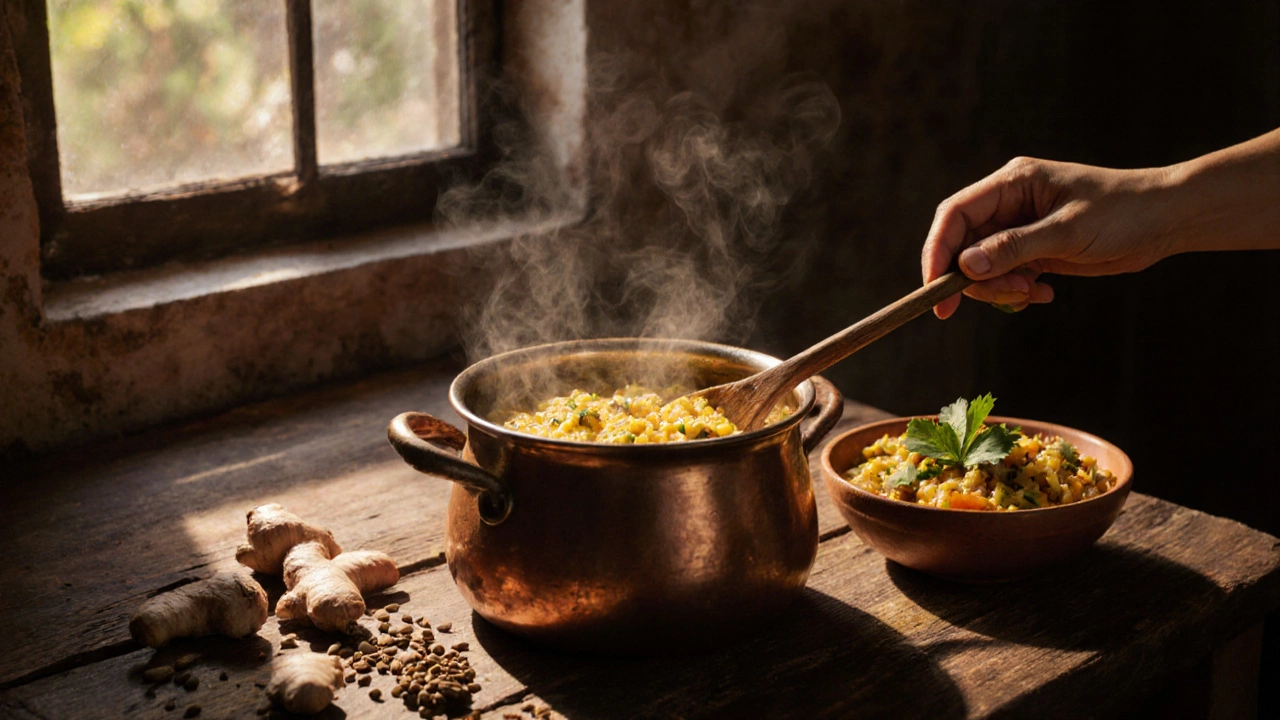
Ayurveda Diet Guide: How to Eat Properly for Balanced Health
Ayurvedic Dosha Calculator
Discover your dominant Ayurvedic dosha with this simple quiz. Your dosha determines your unique physical and mental constitution, helping you make optimal food choices for balanced health.
How It Works
Answer the following questions about your physical characteristics, digestion, and temperament. At the end, we'll determine your dominant dosha and provide personalized dietary recommendations.
Answer the questions above to see your Ayurvedic dosha.
Want to know why the ancient Indian system of Ayurveda diet is still a go‑to for many health‑conscious people? It’s not about fancy superfoods or strict calorie counting. It’s about eating in sync with your body’s unique constitution, the natural rhythm of the seasons, and the fire that burns your food - Agni. Below you’ll find a step‑by‑step plan that turns those lofty concepts into everyday meals you can actually enjoy.
Key Takeaways
- Identify your primary Dosha (Vata, Pitta, Kapha) to choose the right foods.
- Support Agni (digestive fire) by eating warm, freshly cooked meals and avoiding heavy, cold, or processed items.
- Adapt your diet to the seasons - lighter, raw foods in summer; nourishing, cooked meals in winter.
- Practice mindful eating: sit down, chew well, and stop before you’re completely full.
- Use the simple checklist at the end to keep your Ayurvedic eating on track.
1. Discover Your Dosha
The first step in any Ayurvedic eating plan is to figure out which Dosha dominates your constitution. The three doshas - Vata, Pitta, and Kapha - are combinations of the five elements (earth, water, fire, air, ether). A quick self‑assessment (online questionnaire or an Ayurvedic practitioner) will reveal your primary dosha and any secondary influences.
Once you know your dominant dosha, you can tailor food choices, cooking methods, and timing to keep that element in harmony.
2. Keep Agni Strong and Ama Away
In Ayurveda, Agni is the digestive fire that transforms food into energy. When Agni is strong, nutrients are absorbed efficiently; when it’s weak, undigested residue - called Ama - builds up, leading to sluggishness, bloating, and long‑term disease.
Practical tips to boost Agni:
- Eat at regular times, ideally breakfast by 8am, lunch by 1pm, and a light dinner before 7pm.
- Prefer warm, cooked meals over cold salads or leftovers.
- Add digestive spices like ginger, cumin, coriander, and black pepper (all classic Ayurvedic spices).
- Avoid excessive coffee, alcohol, and overly processed snacks that dampen Agni.

3. Seasonal Eating - Align with Nature
Ayurveda teaches that the environment influences your dosha balance. During hot summer months, Pitta tends to rise, while the cold of winter fuels Kapha. Adjusting food temperature, flavor, and heaviness to the season keeps your doshas stable.
| Season | Key Strategies | Recommended Foods |
|---|---|---|
| Spring (Vata‑dominant) | Warm, grounding, slightly sweet | Stews, root vegetables, cooked grains, ghee |
| Summer (Pitta‑dominant) | Cool, slightly bitter, hydrating | Cucumber, leafy greens, coconut water, mint |
| Fall (Kapha‑dominant) | Light, spicy, astringent | Spiced soups, lentils, quinoa, roasted vegetables |
| Winter (Kapha‑dominant) | Rich, warming, oily | Bone broth, almonds, sweet potatoes, warming spices |
4. Food Combining - What Works Together
Ayurveda suggests simple rules for combining foods so they digest together smoothly:
- Fruit is best eaten alone or with other fruits; avoid mixing with dairy or grains.
- Heavy proteins (meat, beans) pair well with cooked vegetables and grains.
- Cold drinks should be consumed between meals, not during eating.
Following these combos reduces Ama formation and keeps Agni humming.
5. Mindful Eating - The Mental Component
Food is not just fuel; it’s an experience. Mindful eating in Ayurveda means:
- Sitting at a clean table without screens.
- Chewing each bite 20‑30 times.
- Pausing between mouthfuls to assess satiety.
- Expressing gratitude for the food’s origin.
These simple habits lower stress hormones, improve digestion, and make the meals more satisfying.

6. Sample Daily Menu for Each Dosha
Below is a quick‑look menu that respects the preferences of each dosha while supporting Agni.
| Dosha | Breakfast | Lunch | Dinner |
|---|---|---|---|
| Vata | Warm oatmeal with ghee, cinnamon, and raisins | Kitchari (mung beans & rice) with sautéed carrots and cumin | Steamed sweet potatoes, spiced lentil soup, a drizzle of clarified butter |
| Pitta | Cooling cucumber‑mint smoothie with a pinch of cardamom | Quinoa salad with roasted zucchini, cilantro, and lime | Grilled fish with coriander‑lime chutney, side of sautéed kale |
| Kapha | Spiced millet porridge with ginger and black pepper | Mixed bean stew with mustard seeds, turmeric, and leafy greens | Roasted cauliflower, quinoa, and a teaspoon of sesame oil |
7. Common Pitfalls and Quick Fixes
Even with the best intentions, many people slip into habits that sabotage Ayurvedic eating. Spot the red flags and adjust fast:
- Skipping meals - leads to weak Agni. Set alarms and keep light, dosha‑friendly snacks handy.
- Over‑reliance on processed foods - adds Ama. Swap packaged snacks for roasted nuts or fresh fruit.
- Drinking ice‑cold water during meals - douses Agni. Switch to warm herbal tea.
- Eating late at night - especially for Kapha types, this creates congestion. Aim to finish dinner by 7pm.
Ayurvedic Eating Checklist
- ✅ Identify primary dosha.
- ✅ Schedule meals at consistent times.
- ✅ Use warming spices daily.
- ✅ Choose foods that match the current season.
- ✅ Practice mindful eating for at least 10 minutes per meal.
- ✅ Review any Ama symptoms (bloating, heaviness) and adjust diet.
Frequently Asked Questions
How do I know which dosha is dominant?
Take a short online quiz that asks about body frame, skin type, digestion, and temperament, or consult an Ayurvedic practitioner for a thorough evaluation. Most people have one primary dosha with a secondary influence.
Can I follow an Ayurvedic diet if I’m vegetarian?
Absolutely. Ayurveda works well with vegetarian meals because it focuses on food quality, preparation, and spice balance rather than meat vs. plant. Use dairy, legumes, nuts, and grains strategically to meet each dosha’s needs.
What if I have a medical condition like diabetes?
Ayurvedic principles can complement conventional care. Focus on low‑glycemic carbs, plenty of bitter greens, and spices like fenugreek that help regulate blood sugar. Always discuss dietary changes with your doctor.
Do I need special ingredients that are hard to find?
Most Ayurvedic spices (turmeric, cumin, coriander, ginger, black pepper) are available in regular supermarkets. For more exotic items like asafoetida or ghee, an Indian grocery store or online market will have them.
How long does it take to feel the benefits?
Many people notice better digestion and steadier energy within a week of consistent practice. Deeper changes - clearer skin, balanced mood, reduced inflammation - often appear after 30‑60 days of steady adherence.

Arnav Singh
I am a health expert with a focus on medicine-related topics in India. My work involves researching and writing articles that aim to inform and educate readers about health and wellness practices. I enjoy exploring the intersections of traditional and modern medicine and how they impact healthcare in the Indian context. Writing for various health magazines and platforms allows me to share my insights with a wider audience.
About
Medical Resource Center India is a comprehensive online platform dedicated to providing reliable health information and medical resources in India. Explore a wide range of articles, tips, and advice on medicine, healthcare services, and wellness. Stay informed about the latest developments in Indian medicine and access valuable insights into maintaining a healthy lifestyle. Discover expert guidance and health solutions tailored for every Indian citizen. Your go-to destination for authoritative medical knowledge in India.







